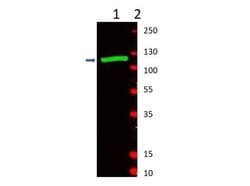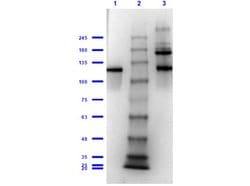Learn More
beta Galactosidase Polyclonal Antibody, Rockland™


Rabbit Polyclonal Antibody
Supplier: Rockland Immunochemicals 2004136S

Description
Store vial at 4°C prior to restoration. For extended storage aliquot contents and freeze at -20°C or below. Avoid cycles of freezing and thawing. Centrifuge product if not completely clear after standing at room temperature. This product is stable for several weeks at 4°C as an undiluted liquid. Dilute only prior to immediate use. Beta-Galactosidase Antibody is an IgG fraction antibody purified from monospecific antiserum by a multi-step process which includes delipidation, salt fractionation and ion exchange chromatography followed by extensive dialysis against the buffer stated above. Assay by immunoelectrophoresis resulted in a single precipitin arc against anti-Rabbit Serum as well as purified and partially purified Beta Galactosidase [E.coli]. Cross reactivity against Beta Galactosidase from other tissues and species may occur but have not been specifically determined. Very low background staining has been reported in various assays.
Beta Galactosidase is an exoglycosidase which hydrolyzes the beta-glycosidic bond formed between a galactose and its organic moiety. Deficiencies in the protein in humans can result in galactosialidosis or Morquio B syndrome. In E. coli, the gene of beta-galactosidase, the lacZ gene, is present as part of the inducible system lac operon which is activated in the presence of lactose when glucose level is low. E. coli beta Galactosidase is commonly used in molecular biology as a reporter marker to monitor gene expression. Another popular use for beta Galactosidase is in blue/white screening to identify recombinant clones. Beta Galactosidase can be split in two peptides, lacZalpha and LacZOmega, neither of which is active by itself but when both are present together, spontaneously reassemble into a functional enzyme. This property is exploited in many cloning vectors. The presence or absence of an active beta Galactosidase may be detected through addition of artificial chromogenic substrates such as X-gal, fluorescent substrates such as Fluorescein di-beta-D-galactopyranoside (FDG), luminescent substrates and others. Beta Galactosidase activity at pH 6 is an indicator of senescent cells not found in presenescent, quiescent or dividing cells.Specifications
| beta Galactosidase | |
| Polyclonal | |
| Unconjugated | |
| Acid beta-galactosidase; AW125515; betagal; Beta-Gal; Beta-galactosidase; bgal; Bge; Bgl; Bgl-e; Bgl-s; Bgl-t; Bgs; Bgt; C130097A14Rik; EBP; Elastin receptor 1; elastin receptor 1, 67kDa; ELNR1; galactosidase beta 1; galactosidase, beta 1; Glb1; Glb-1; Lactase; lysosomal beta-galactosidase; MPS4B; ßgal; ß-gal; ß-galactosidase | |
| Full length native Beta Galactosidase isolated from E.coli | |
| RUO | |
| Bacteria | |
| Antibody |
| ELISA, Immunofluorescence, Immunohistochemistry, Immunoprecipitation, Western Blot | |
| 1 mg/mL | |
| 0.02M potassium phosphate with 0.15M NaCl and 0.01% sodium azide; pH 7.2 | |
| Rabbit | |
| 25 μL | |
| Primary | |
| Store at 4°C short term. For long term storage, store at -20°C, avoiding freeze/thaw cycles. | |
| Lyophilized |
The Fisher Scientific Encompass Program offers items which are not part of our distribution portfolio. These products typically do not have pictures or detailed descriptions. However, we are committed to improving your shopping experience. Please use the form below to provide feedback related to the content on this product.

